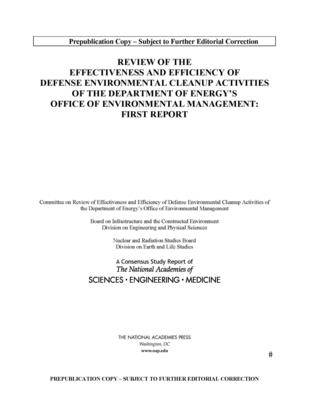
- Retrait gratuit dans votre magasin Club
- 7.000.000 titres dans notre catalogue
- Payer en toute sécurité
- Toujours un magasin près de chez vous
- Retrait gratuit dans votre magasin Club
- 7.000.0000 titres dans notre catalogue
- Payer en toute sécurité
- Toujours un magasin près de chez vous
Effectiveness and Efficiency of Defense Environmental Cleanup Activities of Doe's Office of Environmental Management
Report 1
National Academies of Sciences Engineering and Medicine, Division on Earth and Life Studies, Nuclear and Radiation Studies Board, Division on Engineering and Physical Sciences, Board on Infrastructure and the Constructed Environment, Committee on Review of Effectiveness and Efficiency of Defense Environmental Cleanup Activities of the Department of Energy's Office of Environmental ManagementDescription
The U.S. Department of Energy (DOE) and its predecessor agencies have conducted activities to develop atomic energy for civilian and defense purposes since the initiation of the World War II Manhattan Project in 1942. These activities took place at large federal land reservations of hundreds of square miles involving industrial-scale operations, but also at many smaller federal and non-federal sites such as uranium mines, materials processing and manufacturing facilities. The nuclear weapons and energy production activities at these facilities produced large quantities of radioactive and hazardous wastes and resulted in widespread groundwater and soil contamination at these sites. DOE initiated a concerted effort to clean up these sites beginning in the 1980s. Many of these sites have been remediated and are in long-term caretaker status, closed or repurposed for other uses.
Review of the Effectiveness and Efficiency of Defense Environmental Cleanup Activities of the Department of Energy's Office of Environmental Management: First Report provides background information on the sites currently assigned to the DOE's Office of Environmental Management that are undergoing cleanup; discusses current practices for management and oversight of the cleanups; offers findings and recommendations on such practices and how progress is measured against them; and considers the contracts under which the cleanups proceed and how these have been and can be structured to include incentives for improved cost and schedule performance.
Spécifications
Parties prenantes
- Auteur(s) :
- Editeur:
Contenu
- Nombre de pages :
- 158
- Langue:
- Anglais
Caractéristiques
- EAN:
- 9780309685764
- Date de parution :
- 04-09-21
- Format:
- Livre broché
- Format numérique:
- Trade paperback (VS)
- Dimensions :
- 152 mm x 229 mm

Les avis
Nous publions uniquement les avis qui respectent les conditions requises. Consultez nos conditions pour les avis.






